Crank J. Free and Moving Boundary Problems
Подождите немного. Документ загружается.

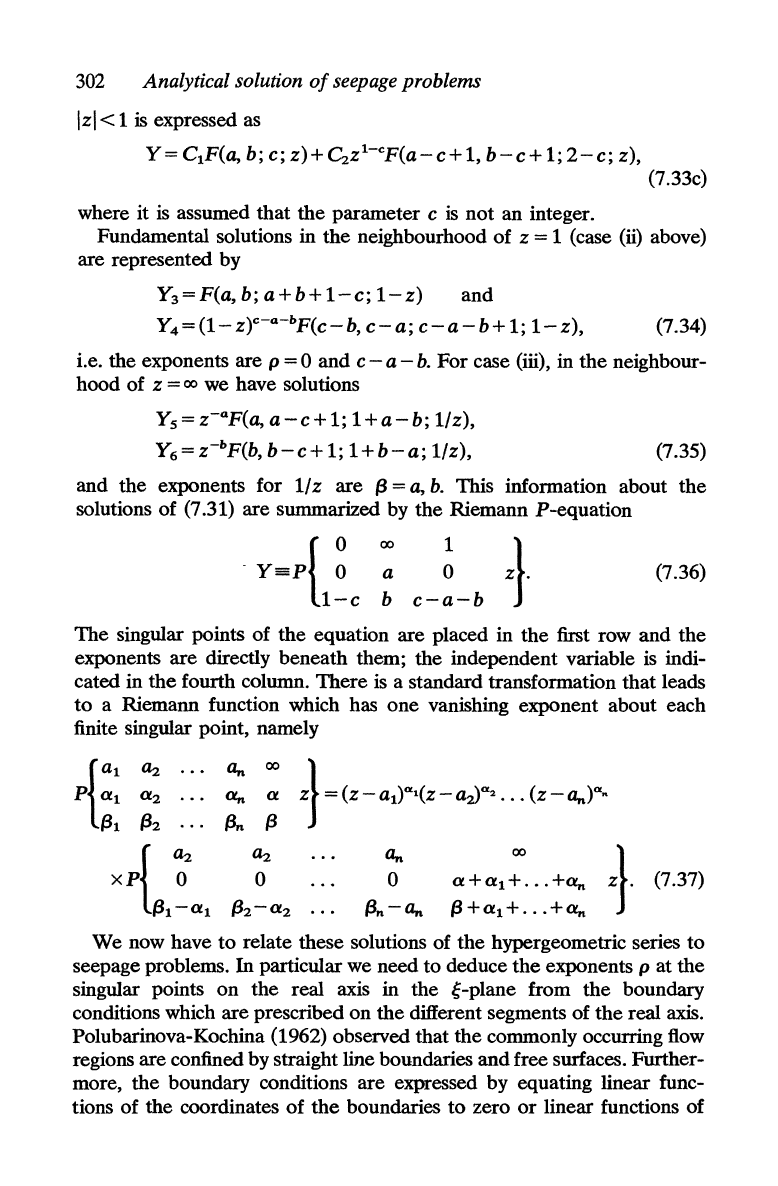
302
Analytical solution
of
seepage
problems
Izl
< 1
is
expressed as
y=
C
1
F(a,
b;
c;
z)+Cz
z
1-
C
P(a-c+
1,
b-c+
1;
2-c;
z),
(7.33c)
where it
is
assumed that
the
parameter c
is
not
an integer.
Fundamental solutions in the neighbourhood of
z = 1 (case (ii) above)
are represented by
Y3
=
P(
a,
b; a + b +
1-
c;
1-
z)
and
Y4
=(1-
z)c-a-bp(c-b,
c-
a;
c-a-b+
1;
1-
z),
(7.34)
i.e. the exponents are
p = 0 and c -
a-b.
For case (iii), in
the
neighbour-
hood of
z =
00
we have solutions
Y
s
= z-ap(a, a
-c
+ 1; 1
+a-b;
1/z),
Y
6
= z-bp(b,
b-c+
1; 1
+b-a;
liz),
(7.35)
and
the
exponents for
liz
are
(3
=
a,
b.
This information about
the
solutions of (7.31) are summarized by the Riemann P-equation
YSP{
~
l-c
b
a
1 }
o
z.
c-a-b
(7.36)
00
The
singular points of
the
equation are placed in
the
first row and
the
exponents are directly beneath them; the independent variable
is
indi-
cated in
the
fourth column.
There
is
a standard transformation that leads
to
a Riemann function which has one vanishing exponent about each
finite singular point, namely
r
~
...
a,.
00
z}
~
(z
-
.,)"·(z
-
0,)-'
...
(z
-a,.)"
P a1
a2
... a,. a
(31
(32
...
f3n
(3
{
~
a2
a,.
00
+
xP
0
0
0
a+a1+··
. + a,.
(7.37)
(31-
a
1
(32-
a
2
(3n
- a,.
(3
+ a1 +
...
+ a,.
We
now have to relate these solutions of the hypergeometric series to
seepage problems.
In
particular we need to deduce
the
exponents p at the
singular points on the real axis in the g-plane from
the
boundary
conditions which are prescribed on
the
different segments of
the
real axis.
Polubarinova-Kochina (1962) observed that the commonly occurring flow
regions are confined by straight line boundaries and free surfaces. Further-
more,
the
boundary conditions are expressed by equating linear func-
tions of the coordinates of
the
boundaries
to
zero
or
linear functions of
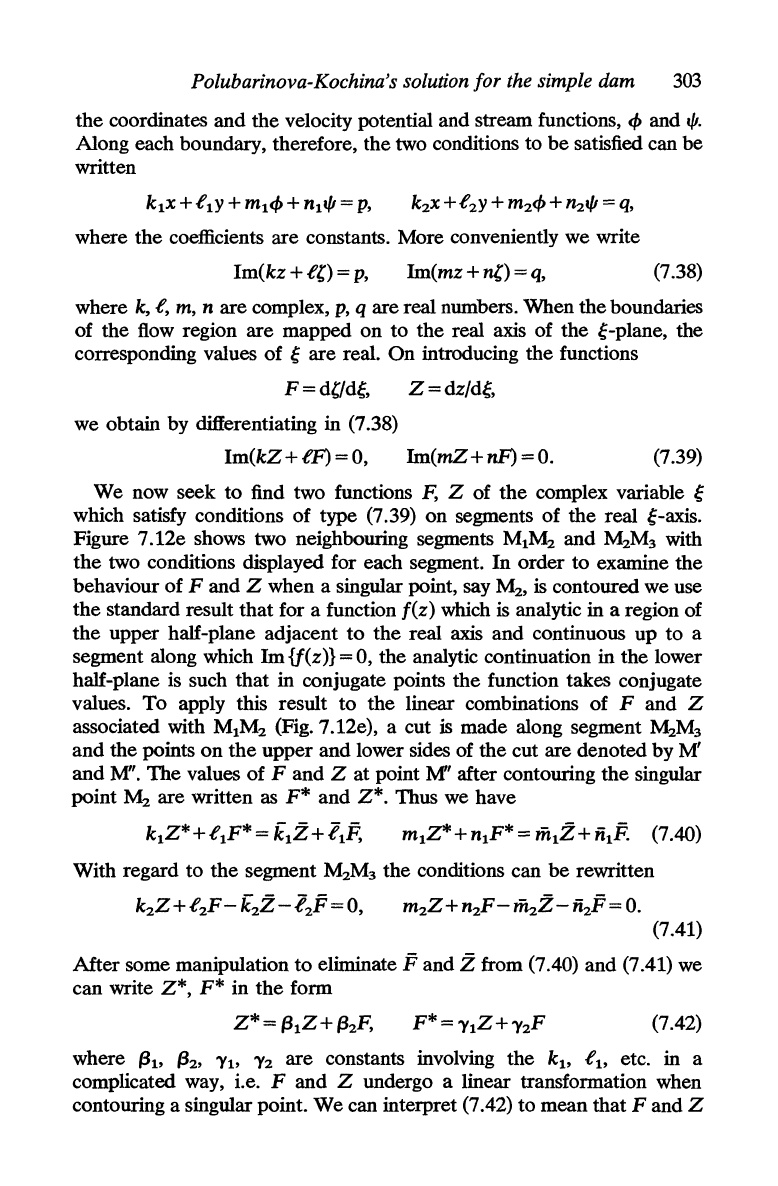
Polubarinova-Kochina's solution for the simple dam
303
the coordinates and the velocity potential and stream functions,
q,
and
"'.
Along each boundary, therefore, the two conditions to
be
satisfied can be
written
where
the
coefficients are constants. More conveniently we write
Im(kz+f{)=p,
Im(mz +
n{)
==
q,
(7.38)
where
k,
f,
m,
n are complex,
p,
q are real numbers.
"When
the boundaries
of the flow region are mapped on to the real axis of the
~-plane,
the
corresponding values of
~
are real.
On
introducing the functions
F==d{/d~,
Z=dz/d~,
we obtain by differentiating in (7.38)
Im(kZ
+ fF) = 0,
lm(mZ
+ nF) = 0. (7.39)
We now seek to find two functions
F, Z of
the
complex variable
~
which satisfy conditions of type (7.39) on segments of
the
real
~-axis.
Figure 7.12e shows two neighbouring segments
MIM2
and
M2M3
with
the
two conditions displayed for each segment.
In
order to examine the
behaviour of
F and Z when a singular point, say M
2
,
is
contoured we use
the
standard result that for a function
f(z)
which
is
analytic in a region of
the
upper half-plane adjacent
to
the real axis and continuous
up
to a
segment along which
1m
{f(z)}
= 0, the analytic continuation in the lower
half-plane is such that in conjugate points
the
function takes conjugate
values.
To
apply this result to the linear combinations of F and Z
associated with MIM2 (Fig. 7. 12e), a cut
is
made along segment
M2M3
and
the points
on
the
upper and lower sides of the cut are denoted by M'
and
M".
The values of F and Z at point
M'
after contouring the singular
point
M2
are written as
F*
and
Z*.
Thus we have
klZ*+flF*=klZ+llF.
mlZ*+nlF*=fiilZ+;itF.
(7.40)
With regard to
the
segment
M2M3
the conditions can
be
rewritten
(7.41)
After some manipulation to eliminate
F and Z from (7.40) and (7.41) we
can write
Z*,
F*
in
the
form
(7.42)
where
(310
(32,
'Ylo
'Y2
are constants involving the
klo
flo etc. in a
complicated way, i.e.
F and Z undergo a linear transformation when
contouring a singular point. We can interpret (7.42) to mean that
F and Z
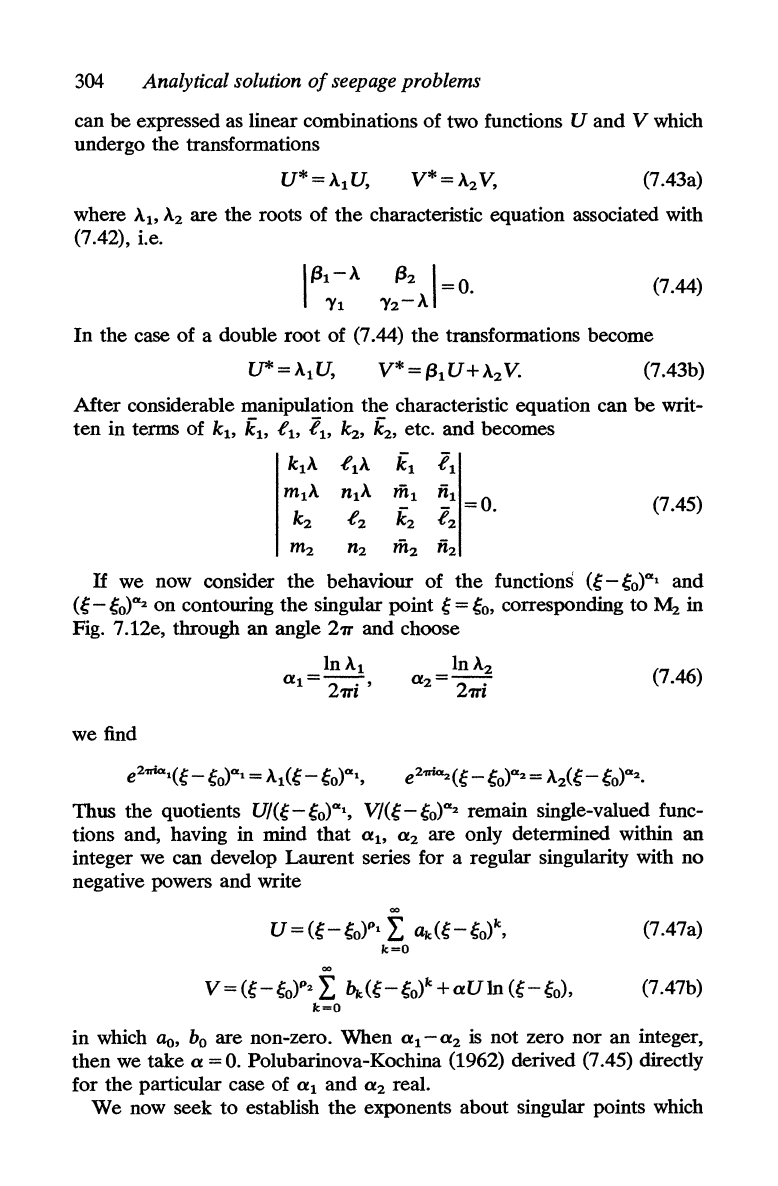
304
Analytical solution
of
seepage problems
can
be
expressed as linear combinations
of
two functions U
and
V which
undergo
the
transformations
U* =
At
U,
V*
=
A2
V, (7.43a)
where
A10
A2
are
the
roots
of
the
characteristic equation associated with
(7.42), i.e.
I
(3t
- A
(32
I =
o.
'Yt
'Y2-
A
(7.44)
In
the
case
of
a double
root
of (7.44)
the
transformations become
U*=At
U
,
V*=(3tU+A2V.
(7.43b)
After
considerable manipulation
the
characteristic equation can
be
writ-
ten
in
terms
of
kt,
k10
.f1o
ft, k2'
k2'
etc.
and
becomes
ktA .ftA
kt
f
t
mt
A
nt
A
mt
nt
=0.
(7.45)
k2
.f2
k2
f2
m2
n2
m2
n2
H we now consider
the
behaviour
of
the
functions
(e
-
eo)'"l
and
(e
-
eoyx2
on
contouring
the
singular
point
~
=
eo,
corresponding
to
M2
in
Fig. 7.12e, through
an
angle
2'7T
and
choose
we find
In
At
at
=
2'7Ti
'
(7.46)
Thus
the
quotients
UI(~
-
eoYx"
V/(e
-
~0)"2
remain single-valued func-
tions and, having in mind
that
a10
a2 are only determined within
an
integer we can develop
Laurent
series for a regular singularity with
no
negative powers
and
write
00
U=(e-eo)Pl
L
tlJc(~_~o)k,
(7.47a)
k=O
00
V=(~-~0)P2
L
~(~-eo)k+aUln(~-~o),
(7.47b)
k=O
in
which ao, b
o
are
non-zero.
When
at-a2
is not zero
nor
an
integer,
then
we take a =
o.
Polubarinova-Kochina (1962) derived (7.45) directly
for
the
particular case
of
at
and
a2 real.
We
now seek
to
establish
the
exponents
about
singular points which
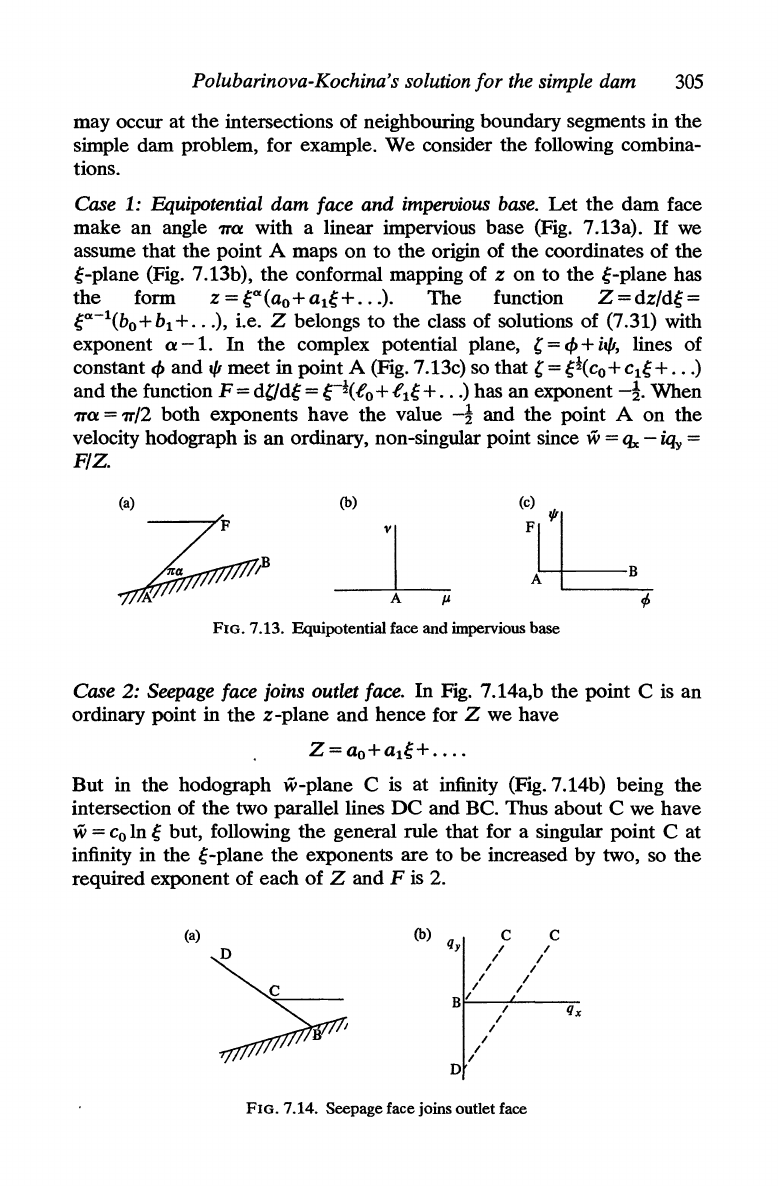
Polubarinova-Kochina's solution for
the
simple dam
305
may occur at
the
intersections of neighbouring boundary segments in the
simple dam problem, for example.
We
consider the following combina-
tions.
Case 1:
Equipotential dam face and impervious
base.
Let
the
dam face
make an angle
7Ta
with a linear impervious base (Fig. 7.13a).
If
we
assume that the point A maps on to the origin of the coordinates of the
~-plane
(Fig. 7.13b),
the
conformal mapping of z on to
the
~-plane
has
the
form z =
fX(aO+al~+"
.).
The
function
Z=dz/d~=
~a-l(bo+
b
l
+
...
), i.e. Z belongs to the class of solutions of (7.31) with
exponent
a
-1.
In
the
complex potential plane,
,=
q,
+
il/l,
lines of
constant
q,
and
1/1
meet in point A (Fig. 7.13c) so that
'=~!(CO+CI~+"')
and the function
F=
d"d~=
~-!(eO+el~+"')
has an exponent
-~.
When
7Ta
=
7T/2
both exponents have the value -! and the point A on the
velocity hodograph
is
an ordinary, non-singular point since w = llx -
iqy
=
F/Z.
(a)
(b)
~J
(~I
~I
A~
.p
FIG. 7.13. Equipotential face and impervious base
Case 2: Seepage face joins outlet face. In
Fig.
7.14a,b
the
point C
is
an
ordinary point in
the
z -plane and hence for Z we have
Z=aO+al~+"
..
But in the hodograph w-plane C is at infinity (Fig.7.14b) being the
intersection of
the
two parallel lines
DC
and BC. Thus about C we have
w =
Co
In
~
but, following the general rule that for a singular point C at
infinity in the
~-plane
the exponents are to
be
increased by two, so the
required exponent of each of Z and F
is
2.
(a)
(b)
qy
c c
~
/ /
/
I
/
/
/
I
/
/
a/
/
qx
/
/
/
/
/
D
FIG. 7.14. Seepage face joins outlet face
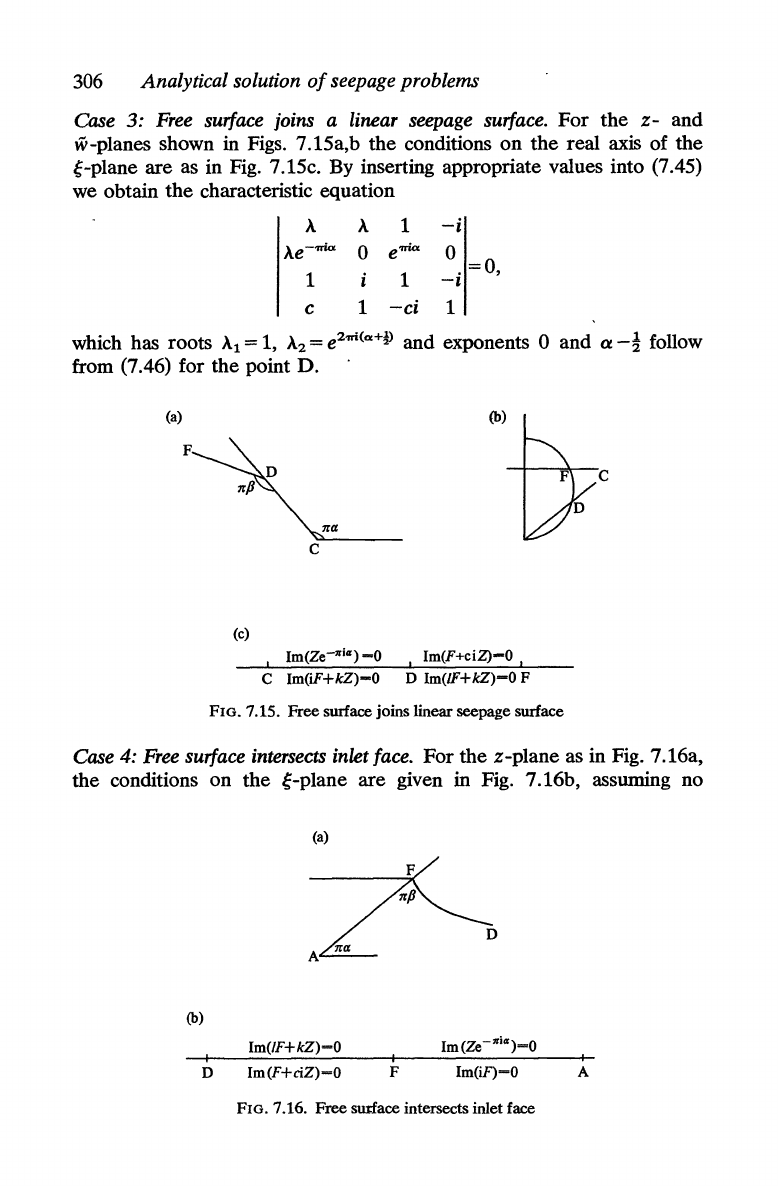
306 Analytical solution
of
seepage problems
Case
3:
Free
surface joins a linear seepage surface.
For
the
z-
and
w-planes shown in Figs. 7.1Sa,b
the
conditions
on
the
real axis of the
~-plane
are
as in Fig. 7.1Sc. By inserting appropriate values into (7.45)
we obtain
the
characteristic equation
A A
1
-i
Ae-'lri<x
0
e'lri<x
0
.
=0,
1 1
-l
C 1
-ci
1
which has roots
A1
= 1,
A2
= e
2m
<a+p
and exponents ° and a
-~
follow
from (7.46) for the point
D.
(a)
(b)
c
n/%
c
(c)
I Im(F+ciZ)-O I
C Im(iF+kZ)-O D
Im(IF+kZ)-O
F
FIG. 7.15. Free surface joins linear seepage surface
Case 4:
Free
surface intersects inlet face.
For
the z-plane as in Fig. 7.16a,
the conditions
on
the
~-plane
are given in Fig. 7.16b, assuming no
(a)
D
(b)
Im(lF+kZ)-O
D
Im(F+ciZ)=O
F
Im(iF)-O
A
FIG. 7.16. Free surlace intersects inlet face
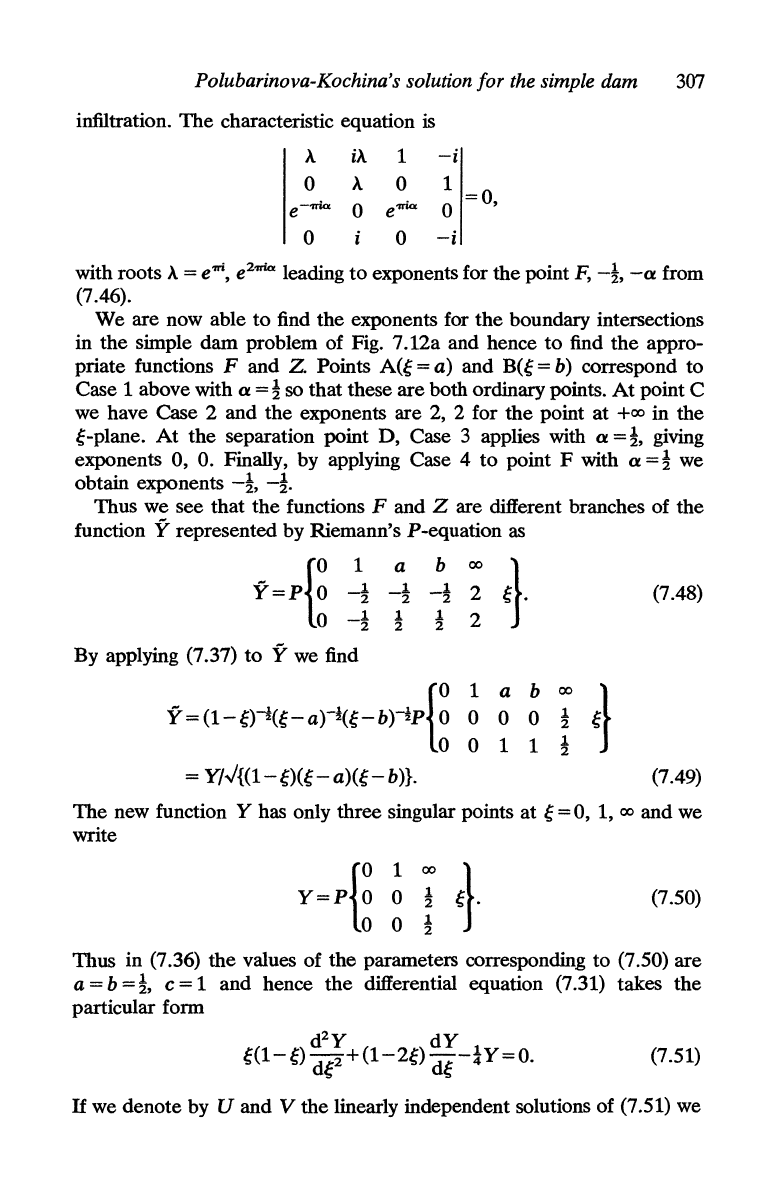
Polubarinova-Kochina's solution for the simple dam
307
infiltration.
The
characteristic equation is
A.
iA.
1
-i
0
A.
0
1
=0,
e-'Iri<>
0
e'lri<>
0
0 0
-i
with roots
A.
=
em,
e
2
'1ri<>
leading
to
exponents for the point F, -t,
-a
from
(7.46).
We are now able
to
find the exponents for
the
boundary intersections
in the simple dam problem of Fig. 7.12a and hence
to
find
the
appro-
priate functions
F and Z. Points
A(~
=
a)
and B(
~
= b) correspond to
Case 1 above with
a = t SO that these are both ordinary points.
At
point C
we have Case 2 and the exponents are 2,
2 for the point at
+00
in the
~-plane.
At
the separation point D, Case 3 applies with a =
t,
giving
exponents 0,
O.
Finally, by applying Case 4
to
point F with a
=t
we
obtain exponents
-t,
-to
Thus we see that
the
functions F and Z are different branches of the
function
Y represented by Riemann's P-equation
as
Y=p{~
-~ ~t
~!
o
-t
t t
By applying (7.37) to Y we find
y
~
(1-
g)-!(g - • )-I(g - b
)-!pU
=
YI.J{(1-~)(~-a)(~-b)}.
(7.48)
(7.49)
The
new function Y has only three singular points
at
~
= 0, 1,
00
and we
write
y=p{~
~
;
J.
o 0 t J
(7.50)
TIIUS
in (7.36) the values of the parameters corresponding to (7.50) are
a = b
=t,
c = 1 and hence
the
differential equation (7.31) takes the
particular form
d
2
y
dY
~(1-~)
de+(1-2~)
d~
-!Y=O.
(7.51)
If
we denote by U and V the linearly independent solutions of (7.51) we
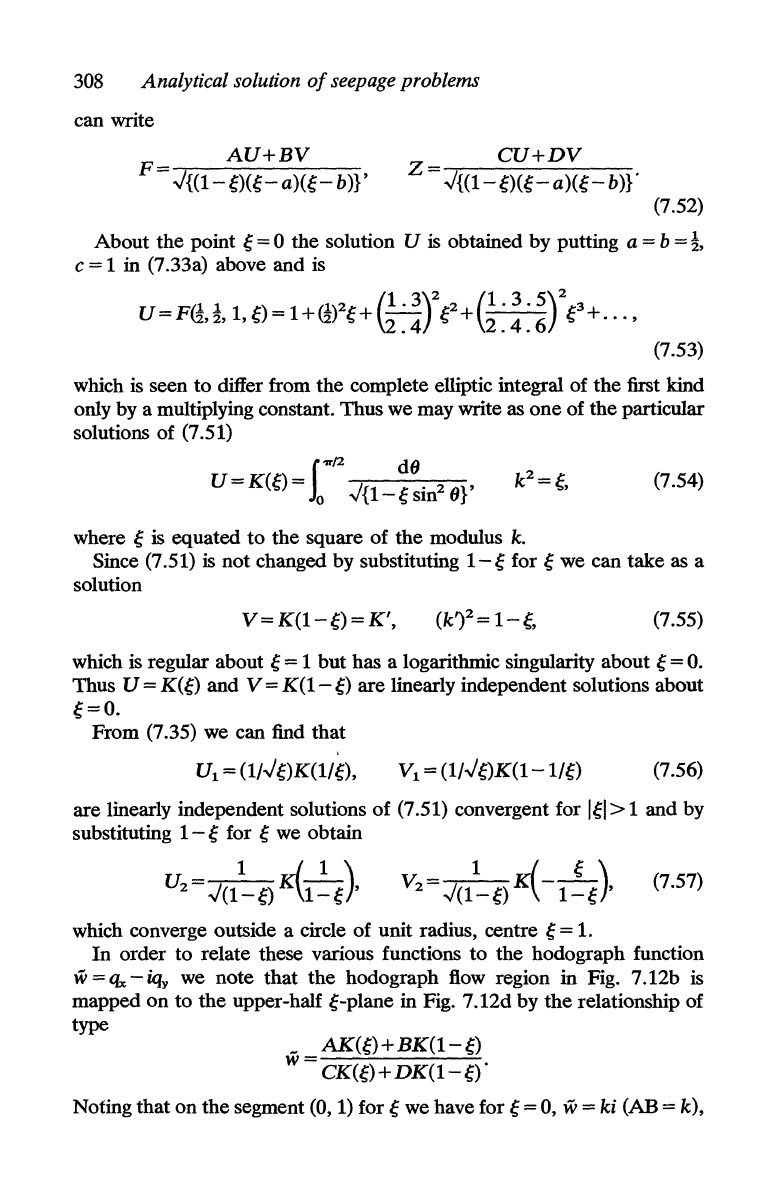
308
Analytical solution
of
seepage problems
can write
AU+BV
F
.J{(1-~)(~-a)(~-b)r
Z=
CU+DV
.J{(1-~)(~-
a)(~-
b)}"
(7.52)
About
the
point
~
= 0
the
solution U
is
obtained
by
putting a = b
=!,
c = 1 in (7.33a) above
and
is
_
(1
1 ) _
(1)2
II.
3)2 2
(1.
3 .
5)2
3
U - F
2, 2,
1,
~
- 1 + 2
~
+
\2
. 4
~
+
2.
4 . 6
~
+
...
,
(7.53)
which is seen
to
differ from
the
complete elliptic integral
of
the
first kind
only by a multiplying constant.
Thus
we may write as
one
of
the
particular
solutions
of
(7.51)
J
"'12
dO
U =
K(~)
= 0
.J{1-
~
sin
2
Or
(7.54)
where
~
is
equated
to
the
square
of
the
modulus
k.
Since (7.51)
is
not
changed by substituting
1-
~
for
~
we can
take
as a
solution
V=K(1-~)=K',
(7.55)
which is regular about
~
= 1
but
has a logarithmic singularity about
~
=
o.
Thus U =
K(~)
and
V =
K(1-~)
are
linearly independent solutions about
~=o.
From
(7.35) we can find
that
U
I
=
(1/.J~)K(1/~),
VI =
(1/.J~)K(1-1/~)
(7.56)
are
linearly independent solutions
of
(7.51) convergent for
1~1>1
and
by
substituting
1-
~
for
~
we obtain
(7.57)
which converge outside a circle
of
unit radius, centre
~
= 1.
In
order
to relate these various functions
to
the
hodograph function
w =
<Ix
-
iqy
we
note
that
the
hodograph flow region
in
Fig. 7.12b is
mapped
on
to
the
upper-half
~-plane
in Fig. 7.12d by
the
relationship of
type
_
AK(~)+
BK(1-~)
w
CK(~)
+
DK(1-~)
.
Noting
that
on
the
segment
(0,1)
for
~
we have for
~
= 0, w =
ki
(AB = k),
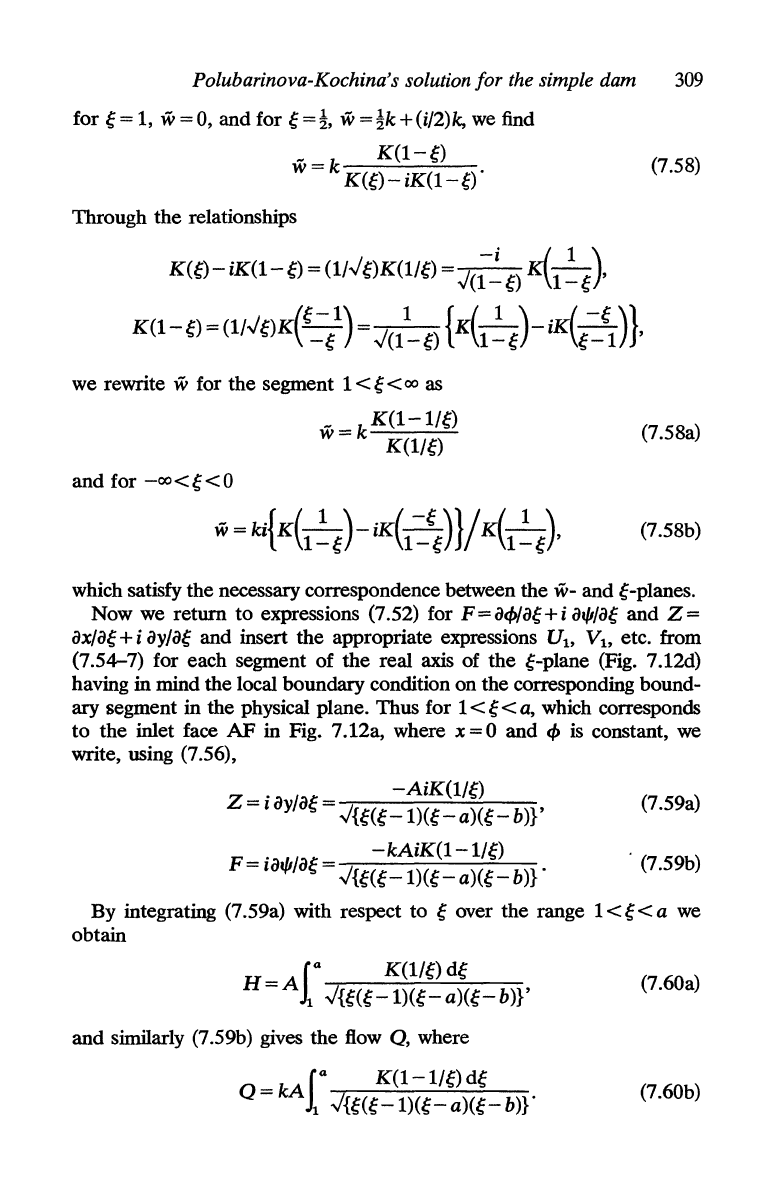
Polubarinova-Kochina's solution for
the
simple
dam
309
for
~
= 1, W = 0, and for
~ =~,
W =
~k
+ (i/2)k,
we
find
_
K(l-~)
w = k
K(~)-
iK(l-~)
Through the relationships
we rewrite
w for the segment 1 <
~
<
00
as
and for
-00<~<0
- _ k
K(1-1/~)
w-
K(l/~)
(7.58)
(7.58a)
(7.58b)
which satisfy the necessary correspondence between the
w-
and
~-planes.
Now we return
to
expressions (7.52) for
F=a~/a~+i
a",/a~
and
Z=
ax/a~
+ i
ayla~
and insert the appropriate expressions
U1>
V1>
etc. from
(7.54-7) for each segment of
the
real axis of the
~-plane
(Fig. 7.12d)
having in mind the local boundary condition on the corresponding bound-
ary segment in the physical plane. Thus for 1
<
~
< a, which corresponds
to
the inlet face
AF
in Fig. 7.12a, where x = 0 and
~
is
constant,
we
write, using (7.56),
.
-AiK(l/~)
Z = ,
ayla~
=
.j{~(~
-1)(~
_
a)(~
-
b)}'
(7.59a)
.
-kAiK(l-1/~)
F=
,a"'la~
=
.j{~(~-1)(~-
a)(~
- b)} .
. (7.59b)
By integrating (7.59a) with respect to
~
over the range 1 <
~
< a we
obtain
f
a
K(l/~)
d~
H=A
1
J{~(~-l)(~-a)(~-b)}'
(7.60a)
and similarly (7.59b) gives the flow
Q,
where
f
a
K(l-l/~)d~
Q=kA
1
J{~(~-l)(~-a)(~-b)}'
(7.60b)
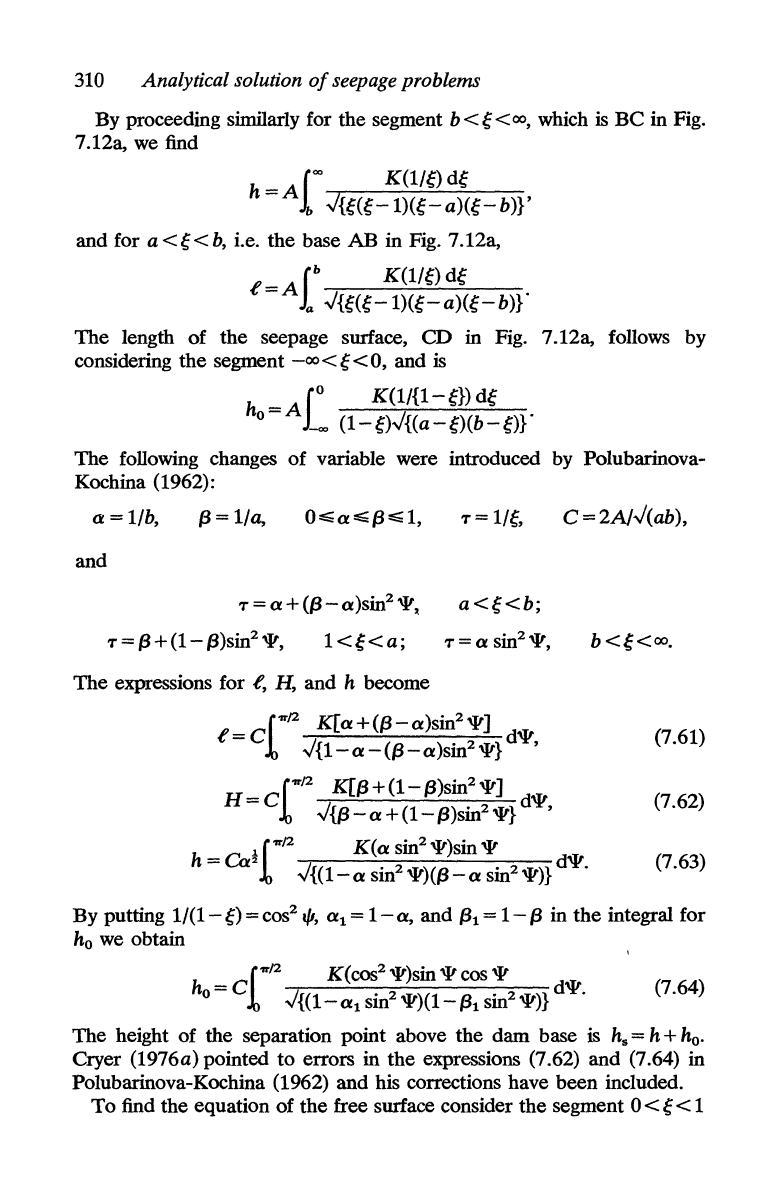
310
Analytical solution
of
seepage problems
By proceeding similarly for the segment b <
~
<
00,
which is
BC
in Fig.
7.12a,
we
find
1
00
K(1/~)
d~
h
==
A
JU(~-1)(~-a)(~-b)}'
and for a <
~
<
b,
i.e. the base
AB
in Fig. 7. 12a,
e-
Ib
K(l/~)
d~
-A
a
v'U(~-1)(~-a)(~-b)r
The length
of
the seepage surface,
CD
in Fig. 7.12a, follows by
considering the segment
-oo<~<O,
and is
1
0
K(1/{1-
~})
d~
ho==A
~
(1-~)~{(a-~)(b-~)r
The following changes of variable were introduced by Polubarinova-
Kochina (1962):
a==l/b, {3=1/a,
O~a~{3~1,
T=1/~,
C==2A1~(ab),
and
T =
a+({3-a)sin2'1'~
a
<~<b;
T={3+(1-f3)sin
2
'1',
1<g<a;
T==asin2'1',
The
expressions for
e,
H, and h become
(7.61)
(7.62)
(7.63)
By putting
1/(1-~)
==
cos
2
I{I,
a
1
=
1-
a, and
{31
==
1-
{3
in
the
integral for
ho
we obtain
1
,"/2
K(COS2
'I')sin
'I'
cos
'I'
ho
= C
J{(1-
a1 sin
2
'1')(1-
{31
sin
2
'I')} d'l'.
(7.64)
The
height of the separation point above the dam base is
hs
= h + h
o
.
Cryer (1976a) pointed to errors in
the
expressions (7.62) and (7.64) in
Polubarinova-Kochina (1962) and his corrections have been included.
To
find the equation of the free surface consider the segment 0 <
~
< 1
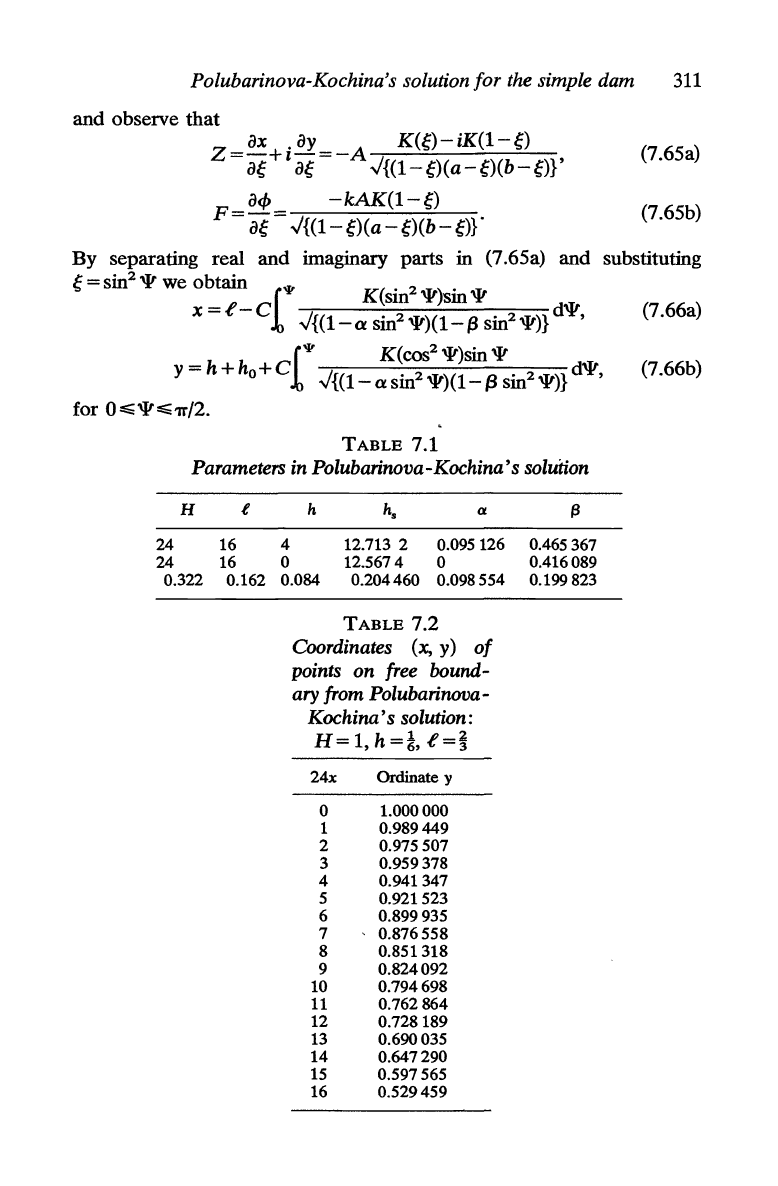
Polubarinova-Kochina's solution for the simple dam
311
and
observe
that
Z=
ax
+i
ay
=-A
K(~)-iK(l-~)
(7.65a)
a~
a~
../{(l-~)(a-~)(b-~)}'
a<f>
-kAK(l-~)
F=
a~
=
../{(l-~)(a-~)(b-~)r
(7.65b)
By
separating
real
and
imaginary
parts
in (7.65a)
and
substituting
KSlD
':t"SlD':t"
~
= sin
2
'I'
we
obtain
1'i'
( . 2
'T")
•
,T,
x =
e-c
../{(l-a
sin2
'1')(1-
~
sin2'1')} d'l',
(7.66a)
(
'i'
K(COS2
'I')sin
'I'
y = h +
ho
+
C"'\J
../{(1-a sin
2
'1')(1-
~
sin
2
'I')} d'l',
(7.66b)
for
O:s;;'I':S;;1T/2.
TABLE
7.1
Parameters in Polubarinova-Kochina' s soluiion
H
t h
h.
a
(3
24
16 4 12.713 2 0.095126 0.465367
24
16 0 12.5674 0
0.416089
0.322 0.162 0.084 0.204460
0.Q98554
0.199 823
TABLE
7.2
Coordinates
(x, y)
of
points on free bound-
ary from Polubarinova-
Kochina's solution:
H =
1,
h =
t,
e =
~
24x
Ordinate
y
0 1.000000
1 0.989449
2 0.975507
3 0.959378
4 0.941347
5 0.921523
6 0.899935
7 0.876558
8 0.851318
9 0.824092
10
0.794698
11
0.762864
12
0.728189
13
0.690035
14 0.647290
15
0.597565
16 0.529459
